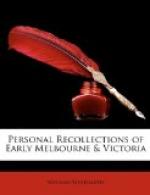As I rode back on my horse to town—for Cobb and Co. had not yet established their leather-hung stage drags, for which, in the impossibility of others upon the unmade roads, we had reason to be thankful—I mused over all I had seen, and long ere reaching home had concluded that 10,000 pounds a day was being taken out of Ballarat. Sundays excepted, that meant a product at the rate of over three millions a year, into which, as one of its export items, the young colony was already “precipitated” from a total export product of only a trifle above a million the year before. No one was prepared to credit such a statement. Indeed, unbelief on the point was prevalent until well on into 1852, when Bendigo had been added to Ballarat, and when Melbourne was seen to be full of gold, which the newly-instituted “gold broker” was already practised, with critical eye as to quality, in weighing out by the hundred or the thousand ounces, and which diggers by hundreds were carrying away in their pockets, in most cases entirely unrecorded, to Tasmania, Sydney, and Adelaide. There was hardly any Customs record at the first, and only a very partial one for a while after, until the diggers ceased thus to carry off the gold, upon finding that the rival brokers gave them fair and full value. The yield of 1852 was estimated at no less than fifteen millions.
How the diggers, utterly inexperienced as they mostly then were, came so suddenly upon such surpassingly rich drifts has never been, to my mind at least, satisfactorily explained, unless the case be summarily affiliated to those possibilities of throwing “sixes” in dozen successions, and such like. In no one year, since 1852, have the Victorian goldfields, although comparatively the most productive, yielded even a near approach to fifteen millions.
MOUNT ALEXANDER AND BENDIGO.
“Our fortune lies upon this jump.”
—Antony and Cleopatra.
The following year, about the same pleasant spring season, I made out a second goldfields visit, in company with my late friend, Mr. W.M. Bell, senior partner of the early firm of Bells and Buchanan. This time I went further inland, and in the more northerly direction of Mount Alexander and Bendigo, as considerable regions around were then loosely called, and which are now represented respectively by the large municipalities of Castlemaine and Sandhurst. Vast changes had taken place in the colony since my Ballarat visit. There had been, in the first place, arrivals in multitudes, first from the surrounding colonies, and then from Home, and, in a lesser influx, from the Cape, America, and parts of Europe. The tide of such threatening dimensions from China was later on. The roads, such as they were, were crowded with passengers; and with traffic, chiefly in flour, to the starving diggers, the carriage of which to Bendigo ran up to 100 pounds a ton. Indeed, such was the cost of carriage




